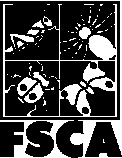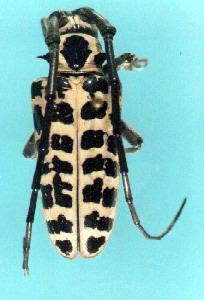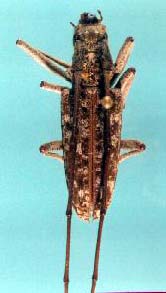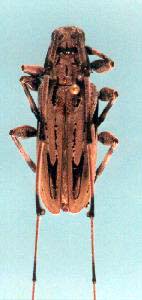

 |
| DPI Photos by Jeff Lotz |
With more than 200 species recorded from Florida, the longhorn beetles are a diverse and important component of the beetle fauna in many Florida woodlands. Although the great majority of the species feed on trees and other woody plants as larvae, most of these attack only dead or dying trees and are harmless or even beneficial to human economic interests, helping to recycle dead wood back into the soil.
The Asian longhorn beetle, however, attacks many kinds of living hardwood trees and has the potential to devastate North America's great eastern hardwood forests. Thus far, its range in North America is restricted to the vicinity of New York City and Chicago, where it was unintentionally introduced in wooden crates from China. It has not been found in Florida. In fact, there is some doubt whether it could survive this far south, although it extends into some relatively warm areas of Asia.
The Department of Agriculture and Consumer Services already has received calls from residents who thought they have sighted this beetle within the state. All the reports have turned out to be native Florida species with varying degrees of similarity to the Asian longhorn beetle. It was thought, therefore, that a pictorial comparison of the Asian longhorn beetle and some Florida species would be of some value to concerned homeowners.
| 1 | 2 | 3 | 4 |
 |
 |
 |
 |
| Plectrodera scalator | Anoplophora glabripennis | Monochamus carolinensis | Acanthocinus nodosus |
1. Plectrodera scalator (Fabricius), known as the cottonwood borer, is white with black markings. It is found only in a few northern Florida counties, and is restricted to cottonwood trees. It may have been unintentionally introduced into Florida with cottonwood trees from the Midwest, which are planted for erosion control.
2. Anoplophora glabripennis (Motschulsky), the Asian longhorn beetle, is shining black with white markings. The antennae are black, banded with white. Thus far it has not been found in Florida. It attacks many hardwood trees, but seems to prefer maple and horsechestnut in the northeastern United States. It has been recorded from Citrus spp.
3. Monochamus carolinensis (Olivier), a pine sawyer, is mottled brown and white. The female and male are pictured together in the smaller photograph; the male alone is enlarged. The antennae are very long in males, 2-3 times the length of the body. It is restricted to pines.
4. Acanthocinus nodosus (Fabricius) is greyish brown with black markings. Like individuals of Monochamus the antennae are very long. It also is restricted to pines.
If you see a beetle that resembles the picture of the Asian longhorn beetle, the most important thing you can do is capture it intact. None of these beetles can sting, and although they can pinch with their mandibles they are not strong enough to break the skin. Suspect beetles can be killed and preserved in regular rubbing alcohol (70% isopropyl) in a liquid-proof container (a 35mm film canister is perfect) and mailed in a padded box to: M.C. Thomas, Florida State Collection of Arthropods, Division of Plant Industry, P.O. Box 147100, Gainesville, FL 32614-7100.
6/5/01 jlf